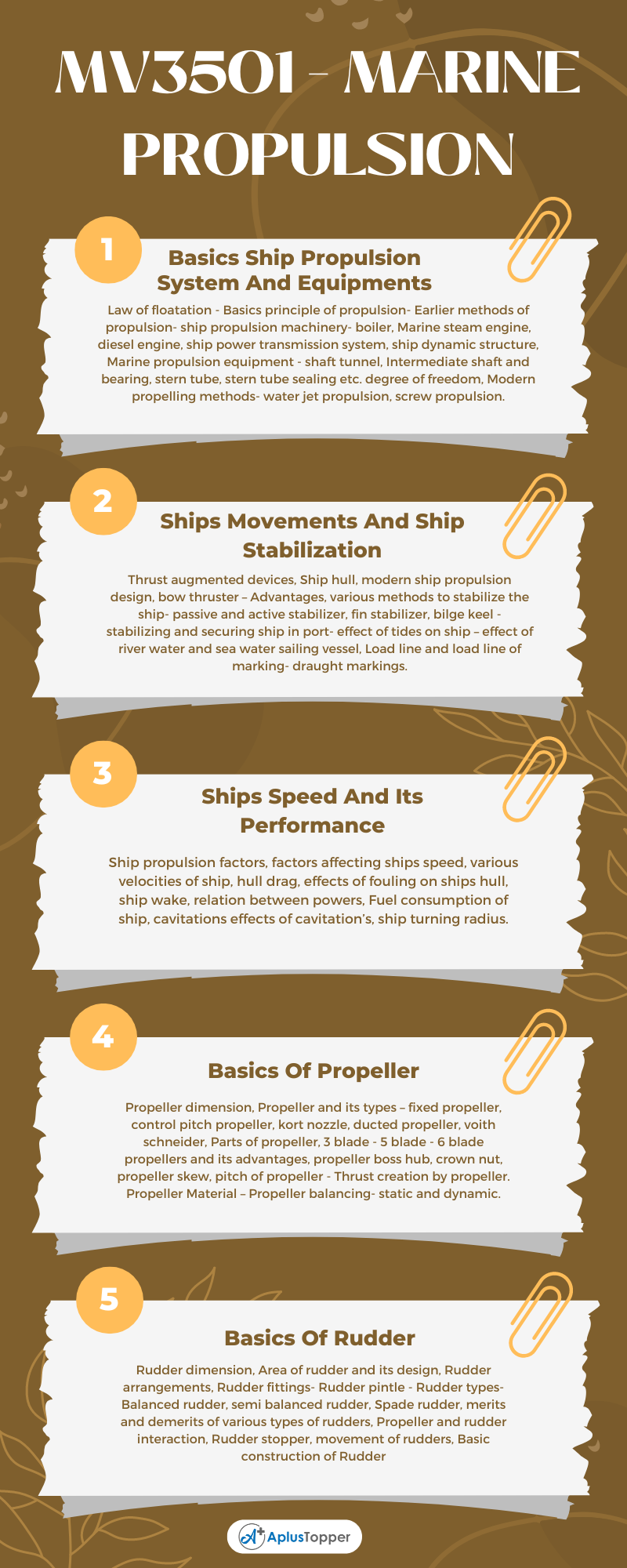Marine Propulsion is a dynamic subject that continuously shifts from one perspective to another. However, the technicality is the same even if the theories and perspectives vary. Hence to gain knowledge in this subject you must be equipped with more vicious on the syllabus.
In this article, we tried to provide the required syllabus of the MV3501 Marine Propulsion subject to gain command of the subject matter. By the end of the course, you will be trained and guided with useful knowledge regarding technical english, which plays a major role in understanding the core of this B.E Marine Engineering semester V related to Affiliated institutions awarded by Anna University course. Hope this information is useful. Kindly share it with your friends. Comment below if you have queries regarding the syllabus.
If you want to know more about the syllabus of B.E. Marine Engineering connected to an affiliated institution’s four-year undergraduate degree program. We provide you with a detailed Year-wise, semester-wise, and Subject-wise syllabus in the following link B.E. Marine Engineering Syllabus Regulation 2021 Anna University.
Aim Of Concept:
- To impart knowledge on basics of propulsion system and ship dynamic movements
- To educate them on basic layout and propulsion equipment’s
- To impart basic knowledge on performance of the ship
- To impart basic knowledge on Ship propeller and its types
- To impart knowledge on ship rudder and its types
MV3501 – Marine Propulsion Syllabus
Unit I: Basics Ship Propulsion System And Equipments
Law of floatation – Basics principle of propulsion- Earlier methods of propulsion- ship propulsion machinery- boiler, Marine steam engine, diesel engine, ship power transmission system, ship dynamic structure, Marine propulsion equipment – shaft tunnel, Intermediate shaft and bearing, stern tube, stern tube sealing etc. degree of freedom, Modern propelling methods- water jet propulsion, screw propulsion.
Unit II: Ships Movements And Ship Stabilization
Thrust augmented devices, Ship hull, modern ship propulsion design, bow thruster – Advantages, various methods to stabilize the ship- passive and active stabilizer, fin stabilizer, bilge keel – stabilizing and securing ship in port- effect of tides on ship – effect of river water and sea water sailing vessel, Load line and load line of marking- draught markings.
Unit III: Ships Speed And Its Performance
Ship propulsion factors, factors affecting ships speed, various velocities of ship, hull drag, effects of fouling on ships hull, ship wake, relation between powers, Fuel consumption of ship, cavitations effects of cavitation’s, ship turning radius.
Unit IV: Basics Of Propeller
Propeller dimension, Propeller and its types – fixed propeller, control pitch propeller, kort nozzle, ducted propeller, voith schneider, Parts of propeller, 3 blade – 5 blade – 6 blade propellers and its advantages, propeller boss hub, crown nut, propeller skew, pitch of propeller – Thrust creation by propeller. Propeller Material – Propeller balancing- static and dynamic.

Unit V: Basics Of Rudder
Rudder dimension, Area of rudder and its design, Rudder arrangements, Rudder fittings- Rudder pintle – Rudder types- Balanced rudder, semi balanced rudder, Spade rudder, merits and demerits of various types of rudders, Propeller and rudder interaction, Rudder stopper, movement of rudders, Basic construction of Rudder
Text Books:
- GP. Ghose, “Basic Ship propulsion”,2015
- E.A. Stokoe “Reeds Ship construction for marine engineers”, Vol. 5, 2010
- E.A. Stokoe, “Reeds Naval architecture for the marine engineers”, 4th Edition, 2009
References:
- DJ Eyers and GJ Bruse, “Ship Construction”, 7th Edition, 2006.
- KJ Rawson and EC Tupper, “Basic Ship theory I” Vol. 1,5th Edition,2001.
Related Posts On Semester – V:
- MV3511 – Electrical Engineering, Electronics and Microprocessor Laboratory
- MV3512 – Marine Machinery Drawing
Must Read For More:
